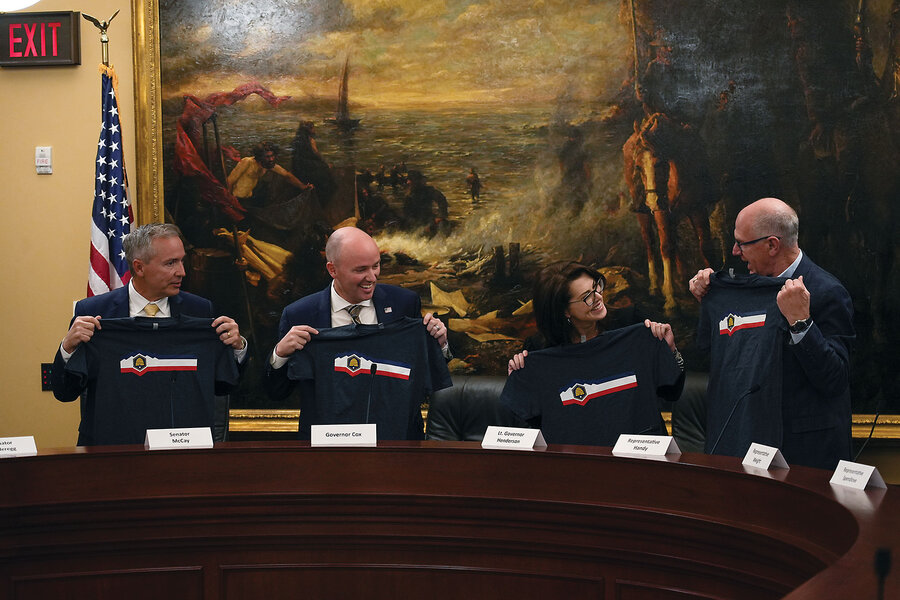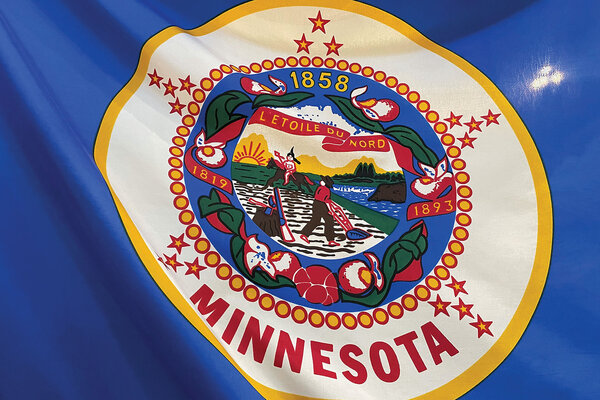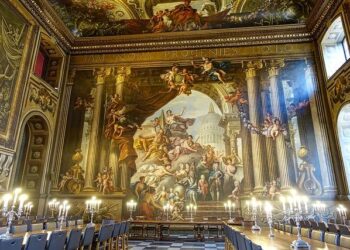When Stephen Handy took his family to cheer on his Utah Utes in the Rose Bowl, he spotted something as exciting as a Hail Mary pass before the game even started. Leading the team onto the field was Utah’s new state flag – a banner featuring dark blue mountains, a red canyon stripe, and a large yellow beehive.
“I said, ‘Wow, that is so great,’” Mr. Handy recalls. “I mean, it was visible. You could see it. It represented Utah to me. It said something.”
Why We Wrote This
A story focused on
The recent wave of flag redesigns reflects awareness that a strong visual identity can bring residents together. The challenge states face, though, is how to agree on symbols that represent everyone.
Mr. Handy should know something about Utah’s new flag, slated to be officially adopted March 9. When he was a state representative, he sponsored bills to study a redesign and create a task force to implement it. Having a flag that people recognize is an important way to stoke civic pride, he says. “I could see, as people began to embrace this, a passion that never, ever has been there in the old state flag.”
Many states fly flags with designs that are centuries old. To preservationists, traditional flags represent shared history and continuity.
But an increasing number of elected officials feel the convention of a “seal on a bedsheet” no longer represents their citizens. Legislators in Illinois, Maine, Massachusetts, Michigan, Minnesota, Pennsylvania, South Dakota, and Utah have all recently passed or filed bills to create flags more evocative of state heritage and iconography.
When Stephen Handy took his family to cheer on his Utah Utes in the Rose Bowl, he spotted something as exciting as a Hail Mary pass before the game even started. Leading the team onto the field was Utah’s new state flag – a banner featuring dark blue mountains, a red canyon stripe, and a large yellow beehive.
“I said, ‘Wow, that is so great,’” Mr. Handy recalls of the January 2023 game in Pasadena, California. “I mean, it was visible. You could see it. It represented Utah to me. It said something.”
Mr. Handy should know something about Utah’s new flag, which was slated to be officially adopted March 9. When he was a state representative, he sponsored bills to study a redesign and create a task force to implement it. Having a flag that people recognize is an important way to stoke civic pride, he says. “I could see, as people began to embrace this, a passion that never, ever has been there in the old state flag.”
Why We Wrote This
A story focused on
The recent wave of flag redesigns reflects awareness that a strong visual identity can bring residents together. The challenge states face, though, is how to agree on symbols that represent everyone.
Many states fly flags with designs that are centuries old. To preservationists, traditional flags represent shared history and continuity.
But an increasing number of elected officials feel the convention of a “seal on a bedsheet” no longer represents their modern citizens. Legislators in Illinois, Maine, Massachusetts, Michigan, Minnesota, Pennsylvania, South Dakota, and Utah have all recently passed or filed bills to create flags more evocative of state heritage and iconography.
There’s not much of a playbook for creating shared symbols. For states taking on new flags, settling on a unified sense of identity and a version of history everyone can agree on has been thorny – as has, in some cases, the question of whether to try doing it at all. But legislators and vexillologists – the term for those who study flags – say the process of picking a new state flag is not just about colors and shapes. Flags hit at the core of residents’ relationships to their history, geography, and collective identity.
Inviting discussion about a new design, though, can reveal just how far apart people’s senses of those concepts lie.

Office of the Lieutenant Governor of Utah
The Utah State Flag Task Force’s (from left to right) Utah state Sen. Dan McCay, Gov. Spencer Cox, Lt. Gov. Deidre Henderson, and then-state Rep. Stephen Handy hold T-shirts featuring the flag’s new design, Nov. 11, 2022, in Salt Lake City.
Finding common ground is the most important part of creating a new flag – and the most difficult, says Josh Mattie, a designer who helped lead a flag project in Cincinnati.
“What really makes a flag important is it being invested with enough true meaning, but also enough broad symbolism that people can
project their own meaning upon it, too,” says Mr. Mattie. “It’s that strange dance of having specificity but also a broadness that can be an umbrella over a larger, changing, diverse populace.”
Jonathan Martin, one of three designers behind Utah’s adopted version, says updating the flag was an inevitable outcome of Utah’s changing population. One of America’s fastest-growing states, he points out, Utah is also the youngest. He says featuring the topography – mountains to the north, red rocks to the south – and the beehive, representing the state’s industriousness, was intended to boost the aspects of Utah that all residents recognize.
“We can do better,” he says. “We can take control of how we want to identify and define who we are as a people.”
But John Hartvigsen, a former North American Vexillological Association president who participated in Utah’s redesign task force, left the process unconvinced that pursuing an update was more important than honoring the emblems and significance of the original flag.
“If we say, well, we need a new state flag to represent the people today,” he asks, “does that mean in 50 years that we should have a new state flag to represent the people as they exist 50 years from now?”
Some opponents say the 1913 flag was “canceled” by legislators. Republican Gov. Spencer Cox signed an order last year to keep the previous flag flying at the Capitol along with the new one. A ballot measure to repeal the change fell short of the necessary signatures.
On Feb. 8, seeking to keep the effort alive, a group brought a lawsuit against the lieutenant governor, challenging the rules around signature collections.
In Minnesota, members of the State Emblems Redesign Commission felt a distinct onus to shift the flag’s historical narrative. The state’s Native tribes have sharply criticized the previous banner for its depiction of an armed white settler working a field while an Indigenous man rides away.

Mohamed Ibrahim/Report For America/AP
Minnesota recently updated its previous flag, which included imagery of an Indigenous person and an armed white settler that Native tribes objected to.
The commission sifted through 2,128 submitted designs – including a handful featuring loons shooting lasers out of their eyes. In December, the group settled on including a minimalist representation of the state’s shape, an eight-pointed North Star, and a vast bright blue field to signify Minnesota’s thousands of lakes and rivers.
Some Minnesotans felt strongly about centering natural elements that all residents could claim. Anne Krisnik made that point on behalf of her children, who teach in local schools.
“One of the things they’ve really talked about … is the love of having a flag that kids can look at and see what it means to Minnesota,” she told the commission. “The waters of Minnesota are something that people can look at the flag and really identify.”
But to others, focusing on a few broad elements felt too reductive.
“It’s just largely missing anything that people can relate to, that demonstrates that [the flag] is about them,” state Sen. Steve Drazkowski, a nonvoting member of the commission, told the Monitor. He worried, also, about the process of creating a flag by committee, instead of allowing state legislators or voters to make the final call.

Courtesy of The State Emblems Redesign Commission
The new Minnesota flag includes a representation of the state’s shape and a bright blue field to signify Minnesota’s thousands of lakes and rivers.
Mr. Mattie, of Cincinnati, coordinated a project to design flags for each of the city’s 52 neighborhoods – an experience he says was especially instructive in bridging the gap on questions of identity and history.
When he pitched a flag featuring symbols of a local university and children’s hospital at one neighborhood meeting, residents’ reactions were deeply negative because they felt the imagery centered developers’ narratives about the area.
“Our ideas [were] out of step with the actual values and people of the neighborhood because we were misinformed by what ends up being corporate propaganda,” he says. Armed with the feedback, his team went back to the drawing board and returned with symbols that represented residential architecture, churches, and the neighborhood’s multigenerational ties.
The community engagement process for a design that’s intended to represent everyone is never easy, by its nature, he says. But taking the time to connect with people yields the strongest results.
“It takes a long time to build that trust and that understanding,” he explains, “and to hear what people actually believe represents them.”
>>> Read full article>>>
Copyright for syndicated content belongs to the linked Source : The Christian Science Monitor – https://www.csmonitor.com/USA/Society/2024/0307/Stars-and-strife-Who-gets-to-decide-what-appears-on-state-flags?icid=rss































